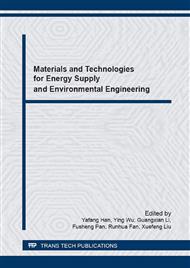[1]
Lan Jun-kang, Wang Yan-xin, Advances in technology of applying iron filings corrosive-cell to the in-situ remediation of groundwater polluted bychlorinated hydrocarbons, Geological Science and Technology Information. 21(2002): 84-88.
Google Scholar
[2]
Xu Si-qin, Wang Yan-xin, Batch Experiments to remove chlorohydrocarbons from wastewaters using surfactant-modified geomaterials, Earth Science-Journal of China University of Geosciences. 29(2004): 55-58+64.
Google Scholar
[3]
Zhai Yali, Wang Xingrun, Shu Xinqian, Experimental study on the remedy of chromium contaminated groundwater with prb technology, Environmental Engineering . S2(2012): 55-58+167.
Google Scholar
[4]
Liu Fei, Zhong Zuo-shen, Treatment technology of volatile chlorinated organic compounds in groundwater by permeable reactive barrier, Earth Science Frontiers. 8(2001): 309-314.
Google Scholar
[5]
Liu Qing-chun, Permeable reactive barrier and electric technology remediate groundwater and soil polluted by heavy metal, HeFei University of Technology. (2013).
Google Scholar
[6]
Ju Liting, Montmorillonite-supported zero-valent Fe/Ni or Fe/Ag bimetallic particles and their application for the removal, South China University of Technology. (2013).
Google Scholar
[7]
Cao Shi-hui, Dai Youzhi, Progresses in research of ultrasound technology for degradation of chloroporganics in water, Environmental Protection of Cheical Industry. 26(2006): 475-479.
Google Scholar
[8]
Cheng Yue, Jiao Chuang, Liu Hai-jiang, Preparation and characterization of coated nanoscale zero-valent iron by using rheological phase reaction method, Chemical Research and Application. 03(2012): 409-413.
Google Scholar
[9]
Mao Yin, Nano zero valent iron treatment of hexavalent chromium in groundwater, Hubei: China University of Geoscience. (2011).
Google Scholar
[10]
Cheng Yue, Jiao Chuang, Fan Wenjing, Synthesis of wrapped nZVI particles and removal of reactive brilliant blue from aqueous solution, Environmental Engineering. 7(2013): 53-57.
Google Scholar
[11]
Luo, S., Qin, P. F., Shao,J. H ., Peng, L., Zeng, Q. R. & Gu, J. D, Synthesis of reactive nanoscale zero valent iron using rectorite supports and its application for OrangeⅡremoval, Chemical Engineering. 223(2013): 1-7.
DOI: 10.1016/j.cej.2012.10.088
Google Scholar
[12]
X. Zhang, S. Lin, Z. Chen, Kaolinite-supported nanoscale zero-valent iron for removal of Pb2+ from aqueous solution: Reactivity, characterization and mechanism, Water Res. 45 (2011) 3481–3488.
DOI: 10.1016/j.watres.2011.04.010
Google Scholar
[13]
Chen K F, Chang Y C, Huang S C, Biodegradation potential of MTBE and BTEX under aerobic, nitrate reducing, and methanogenic conditions at a gasoline-contaminated site, Desalination and Water Treatment. 48(2012): 278-284.
DOI: 10.1080/19443994.2012.698825
Google Scholar


